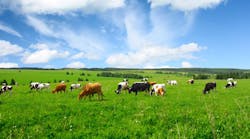How Can Long-Range Narrowband Improve Agricultural Efficiency?
This file type includes high resolution graphics and schematics when applicable.
This is the third installment in a three-part blog series regarding practical applications involving narrowband technology (see Part 1 and Part 2).
The growing population of the world, in addition to changes in food habits, puts pressure on the agriculture sector to grow food more efficiently and preserve and optimize usage of precious natural resources, like fresh water. Most of the world’s water usage goes to agriculture, and the anticipated climate changes will likely make water supplies less predictable.
Agriculture now accounts for roughly 70% of global water usage, but as dietary changes in developing countries raise the demand for water-intensive foods such as meat and dairy, this proportion will continue to grow. Without efficiency gains, agricultural water demand is expected to grow by 45%—or an additional annual 1400 billion cubic meters of water per year—by 2030 (Source: Forbes).
An obvious method to reduce water usage is to use more advanced irrigation systems—only water where needed, when needed. To enable smart irrigation, a system of soil humidity sensors is needed. As farmlands cover large geographical areas, long-range communication is a necessity. A small humidity sensor, equipped with a long-range narrowband-capable radio, can have up to 20 years of battery life and be able to communicate with a central node several kilometers away. Remotely controlled water valves can then be used for targeted irrigation, only where needed, when needed.
Water usage is naturally a function of how much food is produced. It’s a known fact that a high percentage of the foods grown in the world never reach the end consumer. Thus, reducing spoilage will in turn reduce water usage.
Reducing Spoilage
There are many reasons a lot of the food never makes it to your plate. The first is that fresh goods are not handled properly in transit, e.g. due to a broken cold chain. Low-cost, long-range sensors embedded in pallets and containers can give early warning on problems occurring in the cold chain, giving the shipper proper time to react and save the goods.
This is another use-case where low-cost, long-range narrowband sensors can dramatically reduce spoilage in the cold chain, saving cost and improving efficiency. Using long-range narrowband solutions gives wider coverage and better scalability compared to wideband, coding gain solutions. Long-range narrowband technology uses fewer concentrators and, hence, is a more cost-efficient solution.
Infestation Control
To have effective and healthy food production, it’s important to control the environment against infestation, such as rodents. A connected rodent trap might sound like a joke, but in reality, it can offer cost savings in terms of efficiency gains in monitoring and maintaining efficient functionality. Consider the scenario where a producer outsources rodent-trap operations, paying a monthly fee for a healthy, rodent-free environment. The trap operator needs personnel to regularly check the traps, to ensure efficiency and functionality.
However, instead of checking all the traps, all the time, you can use long-range narrowband connectivity to monitor the traps remotely. The trap operator can then change to a targeted operation model. This will result in fewer, timelier visits and better quality of service, with reduced operational costs. This therefore represents a win-win scenario for both parties. A novel method to connect the trap to the Internet is to use a SIGFOX-like network, based on long-range narrowband technology such as TI’s CC1120 wireless solution. This solution removes the need for a local gateway to connect to the end node, by using SIGFOX’s infrastructure.
Controlling water usage, reducing spoilage and keeping a healthy environment are keys to efficient food production. But other applications for wireless sensors can also directly improve the production of milk, as an example.
Cattle Call
The world cattle population will soon break the 1 billion mark. For efficient production of meat and milk, it’s important to inseminate at the right time—miss the slot and you lose one month of production (1/12 or more than 8% of the production for the year). When the cows are ready for insemination, they get much more active than normal. Such movement can be tracked by accelerometers. The return on investment for putting a long-range narrowband sensor on a cow is obvious based on the increased production from the livestock. The sensor can also monitor vital signs of the animal, helping farmers to improve health by catching signs of illness at an early stage.
These are all simple examples of how low-cost, long-range narrowband sensors can improve efficiency in agriculture, from reduction of spoilage, to improvement of health and increased production efficiency.
Hope you enjoyed our three-part series about the possibilities of long-range, narrowband wireless connectivity in real-world applications. From smart gas meters to smoke detectors to even agricultural applications, narrowband RF technology is the de facto standard for long-range connectivity applications. To learn more about TI’s long-range sub-1 GHz solutions, visit www.ti.com/sub1ghz.




